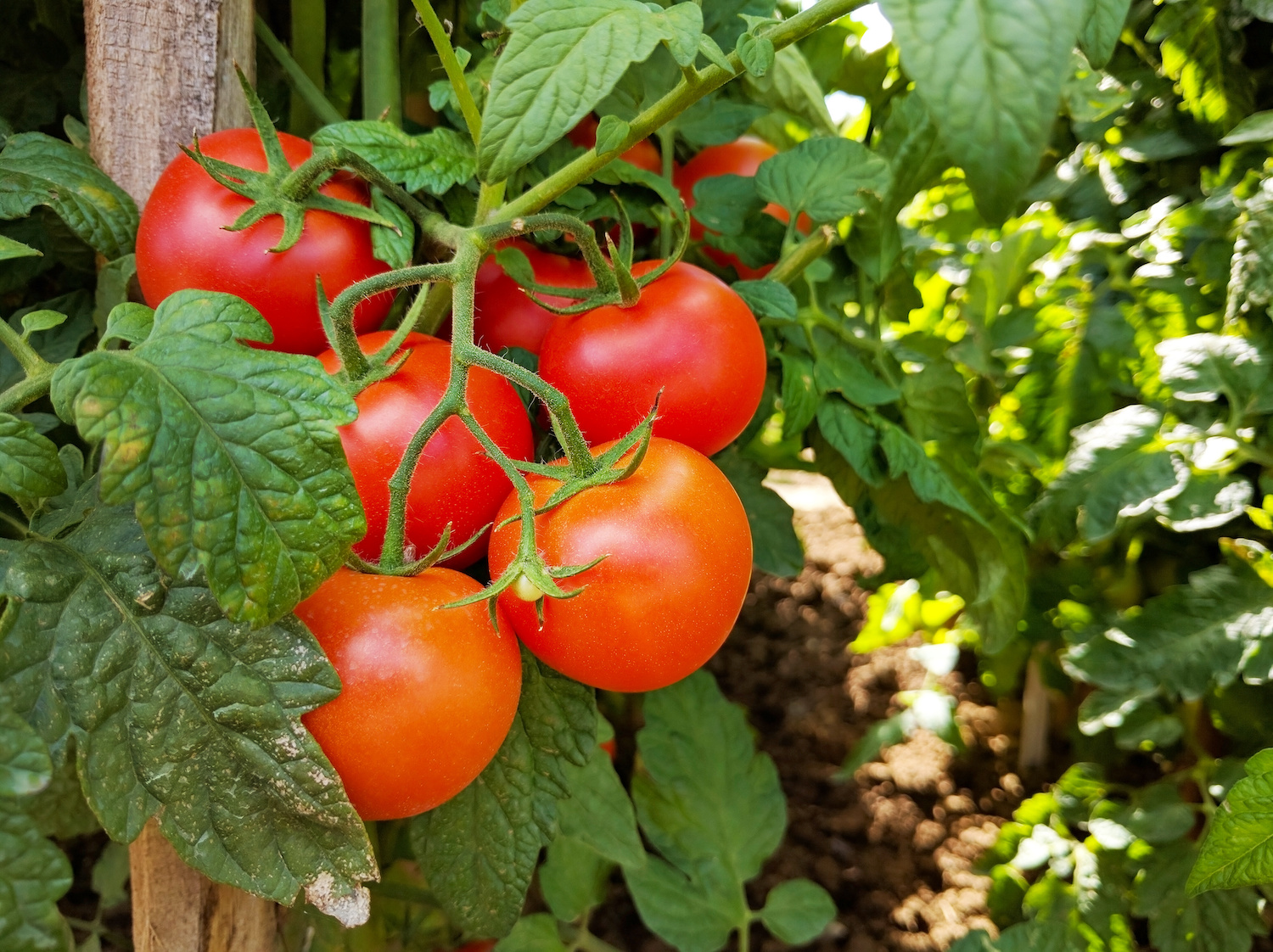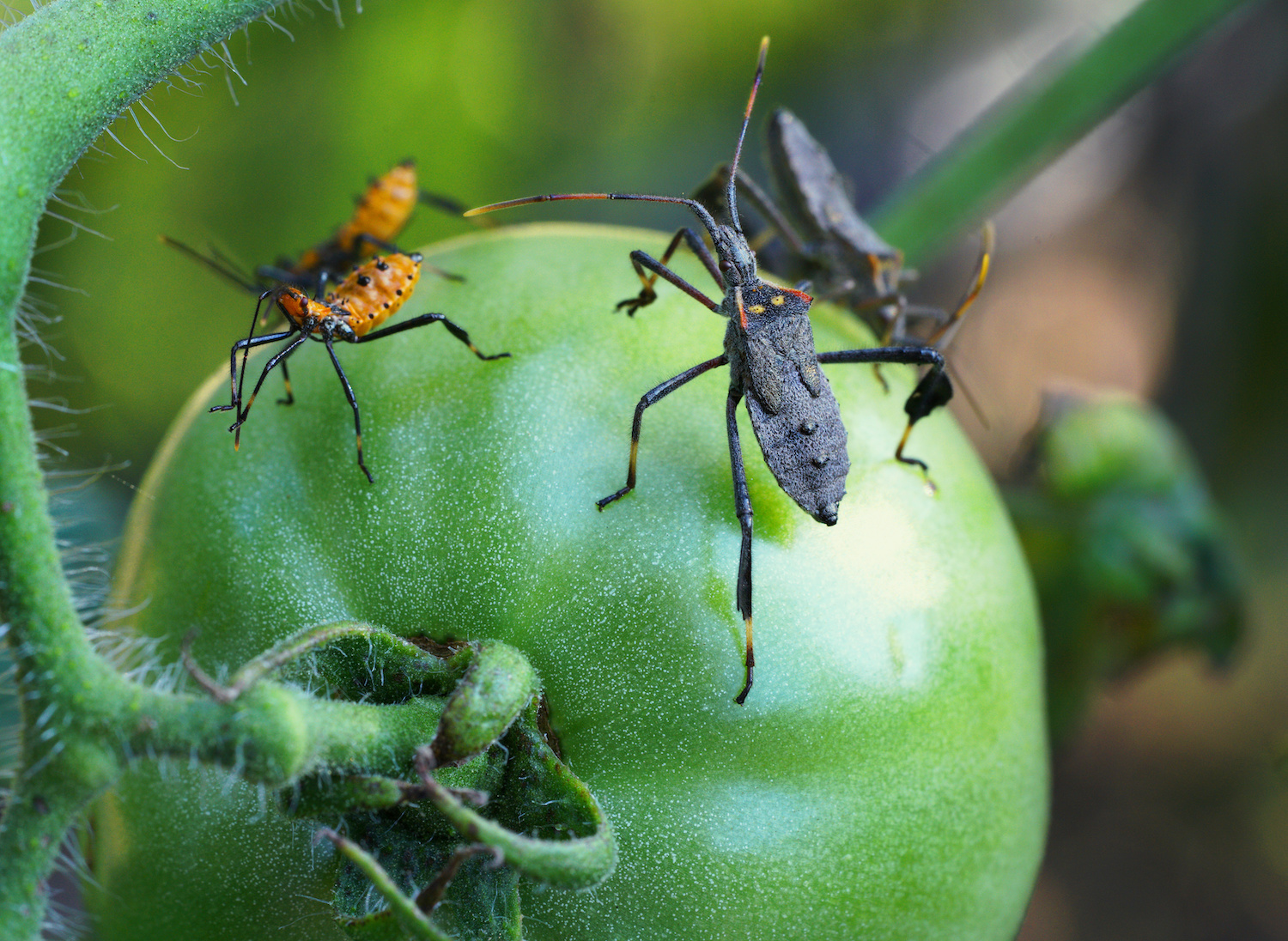
When you harvest your own vine-ripened tomatoes, as compared to what you buy in a typical grocery store, you’ll understand why so many gardeners devote effort to growing these plants! The freshly-harvested fruit, redolent and bursting with flavor, has no comparison. The good news is that tomatoes are not difficult to grow in southern New England, provided you take a few steps to meet their needs.
Lycopersicon esculentum – Love Apples
As a member of the Deadly Nightshade family (Solanum), tomatoes were once thought to be poisonous, and an early name for them was “love apples,” perhaps in reference to their supposed aphrodisiac properties. Tomatoes, being the seed bearing part of the plant, are fruits (botanically a berry), even though we treat them as vegetables culinarily. Today, tomatoes are an essential part of Italian cooking, and used in many other cuisines. In our region, tomatoes are grown as an annual summer crop.
Indeterminate vs. Determinate
The most basic classification of tomatoes is based on their ultimate growth habit: Indeterminate tomatoes produce a vine that keeps on growing, needing some kind of support, until something else (e.g. frost) kills it. Indeterminate varieties keep producing fruit over a long period.
Determinate varieties reach a certain point and grow no taller. This is key for gardeners to know what to expect from the plant – for example, determinate varieties are generally best for container gardens, since they stay smaller. Determinate varieties produce one large crop of fruit, and then finish.
Form and Function
Beyond basic growth habit, tomatoes are further classified based mainly on their intended use.
- Paste or Sauce tomatoes are those that have few seeds, thick walls, less watery flesh, and thus best for making sauce.
- Beefsteak tomatoes are large and typically best for slicing and eating fresh.
- Heirloom tomatoes are especially prized types that have proven themselves for generations (at least 50 years), and are often associated with a particular region.
- Cherry tomatoes are small and sweet, ideal for salads, and produced in abundance.
- Patio/Container varieties are smaller size plants, although the fruit size varies.
The above classifications are merely guidelines – you can certainly eat a sauce tomato raw, and you can also use a slicing tomato in your sauce, it’s just that these types were selected for their specific qualities that make them conducive to certain uses. Likewise, there are types that straddle these classifications.
Growing Requirements
All tomatoes require a rich, well-draining soil, and full sun (at least 6 hours of direct sunlight). Growers often amend the soil with nutrient-rich compost or manure, in addition to organic or synthetic fertilizers to maximize growth. The soil pH should be on the acidic side, about 6-6.5, so be sure to do a soil test before planting and follow recommended instructions for adjusting soil pH if necessary. The soil pH is important because it determines the availability of other nutrients essential for the plant’s needs, especially calcium.
Tomatoes also need a consistent water supply – fluctuations in soil moisture can cause the fruit to crack as a result of uneven growth. Many gardeners will use soaker hoses to evenly supply water to the soil, and reduce or eliminate overhead watering which can cause foliar diseases. Likewise, plastic or organic mulch is also helpful in retaining moisture and ensuring soil warmth. Tomatoes are heat-loving plants, provided they have an ample water supply.
Extending the Season
Since our summers are relatively short, most gardeners in our area will either start tomato seeds indoors before planting outside after danger of frost, or buy starter plants at their local garden center. The advantage to starting your own seeds is that you have a much wider selection as to which varieties you will grow – whereas the plants you buy are usually limited to the most popularly known and grown varieties.
Starting Seeds
Seeds started indoors should be planted no more than 4-6 weeks prior to planting outdoors. Use a sterile seed starting mix, and plant the seeds in biodegradable pots or trays. This reduces the chance of transplant shock because you can plant the entire pot in the ground.
The seeds can be germinated either on a windowsill or under grow lights; using grow lights gives you more flexibility in terms of both the quality and duration of light, but a bright window sill also works, just avoid direct sun which could “cook” your plants. The seed trays should be covered with a clear plastic dome or bag to sustain high humidity until the seeds emerge. Since tomatoes like warmth, using a seedling heat mat greatly increases success and speeds germination.
Once the seeds begin growing, remove the covering so they don’t rot, but provide even moisture without soaking them. The heat mat (if used) can also be removed after the seedlings emerge. After they are about 2-3” tall, a gentle fan helps to improve air circulation and encourages stronger growth.
Hardening Off
The young tomato plants will need to be acclimated to the outdoors before planting. This is a process known as “hardening off.” To do this, bring your tomato plants outside in a lightly
shaded area for half a day for 4-5 days, gradually increasing their amount of time outdoors. Introduce them to more direct sunlight over this time, eventually leaving them out the full day and night, making sure nighttime temperatures will not dip below freezing. After about 7-10 days, your seedlings should be ready to plant in the ground.
Transplanting
Once you’ve selected the area where you will grow tomatoes, and properly prepared the bed by loosening the soil and adding amendments as needed, you can plant. Tomatoes actually benefit from being planted more deeply than they were growing in a container; the stem will send out new roots which will enhance its ability to take up water and nutrients. Prepare a hole, and place the plant, burying it up to the first or second set of leaves—these lower leaves should be removed before planting. Some gardeners will also add bone meal to the hole, which helps to provide calcium for the growing fruit.
Water the new transplants well to be sure there are no air pockets in the planting hole. This would also be the time to use a liquid starter fertilizer if you choose, which is mixed with the water, and helps to reduce transplant shock.
Growing
The tomato plants will grow quickly once they are established. Be sure to give them a regular supply of water, especially if rain is inadequate. Unless you used a slow-release fertilizer at the time of planting, the plants will likely need a regular, weekly dose of liquid fertilizer. Indeterminate tomato plants will need staking – which can be done with a strong wooden stake or a tomato cage. This is to prevent the plant from falling over when it is laden with heavy fruit.
Many gardeners will also prune their tomato plants; the plant will produce side shoots at each leaf axil along the main stem. These can be removed by pinching or a sharp knife, which will improve air circulation, but reduce the yield slightly while producing larger, more uniform fruit. This is not required – some growers prefer to allow these shoots to grow, resulting in greater yield but smaller fruit. It all depends on what you want from the plant!
Pests and Problems
The most common problem we see with tomato plants is blossom end-rot, or cracking. Blossom end-rot is caused by lack of availability of calcium in the soil, which is related to soil pH noted above, and why we add bone meal to the soil. Cracking is caused by an uneven water supply.
Pests can include aphids, tomato horn worms, white flies, slugs, flea beetles, red spider mites, and others. The best defense is a healthy plant that receives ample sunshine, water and fertilizer, however if you encounter any of these pests there are effective organic controls we can recommend.

Harvesting and Storage
When tomato fruits start ripening, be sure to check them regularly and harvest often. The unwashed fruit will keep, stem side down, at room temperature (don’t refrigerate) for several
days. Tomatoes can be preserved by canning or freezing for later use. In late September or October when frost threatens, be sure to pick any fruit remaining on the plant, even if it isn’t ripe – the fruit can be ripened in a paper bag on the kitchen counter.
End of Season
Tomato plants are very sensitive to cold, so the first frost will kill your plants. They should then be removed from their beds and composted, so long as no diseases are present. Cleaning up any debris helps to reduce the chance of overwintering pests. It is best to rotate where you grow tomatoes every few years, as tomatoes take a lot of energy out of the soil, and rotating reduces the chance of soil-borne diseases. Growing peas or beans in the same bed on “off-years” helps to restore nitrogen to the soil.







